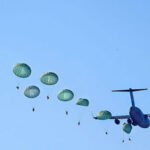Band of Brothers is part history textbook and part long journalistic feature article. The style of writing varies, seemingly always within a single chapter, from the overall historical picture of the Allied invasion of Western Europe in 1944 to detailed description of the events concerning specifically the soldiers of the Easy Company, 506th Parachute Infantry Regiment, 101st Airborne Division, with many quotes from the participants.
This style of writing is typical of Stephen Ambrose. A noted military historian, Ambrose uses this style in all of his books, including Citizen Soldiers, Undaunted Courage, D-Day, and many others. One of his books, Pegasus Bridge: June 6, 1944, is built in exactly the same fashion as Band of Brothers, but rather than American paratroopers, it tells the story of British paratroopers and glider troopers who captured and held an important bridge on the day of the invasion. His knowledge of the events that took place before and after the Normandy invasion is unparalleled by any writer and is probably better than that of many historians. Ambrose’s reputation – in addition to the books already mentioned, he wrote a biography of Dwight Eisenhower, the Supreme Commander of the Allied Forces in European Theater of Operations – has led to him being appointed director of the D-Day museum in New Orleans.
Ambrose’s writing style is, for the most part, dry and to the point, but at the same time very descriptive. The whole book reads like a well-written magazine article. Numerous quotes from his interviews with veterans are a big reason for this. Ambrose does not impose his prose on a reader, but instead lets the events he describes do it for him. It is a smart approach because the events taking place in the book are so powerful in their imagery that there is no need for additional spicing up on the part of the author. There are plenty of amusing moments in the book, but none of them come to be because Ambrose forces them on a reader; instead he tastefully chooses situations that really took place and through his description shows that it was the soldiers who never lost their sense of humor despite the horrors and the hardship that they experienced.
In the foreword to Band of Brothers, Ambrose tells about his work with Steven Spielberg and Tom Hanks on the mini-series based on the book. Aired on HBO, the mini-series went on to win numerous Emmy awards for everything from special effects to original book adaptation. This last one is the most impressive one considering that Spielberg and Hanks had to compress all the events described in the book into twelve one-hour episodes. They achieved it by splitting the book into most important parts: pre-invasion, D-Day and operations in France, operation Garden-Market and the Holland campaign, Bastogne, march through Germany, and the final days of war as an occupation force.
The synopsis of the first four chapters of the book is the training and other preparations for the invasion. Chapter 1 explores the early days of the Easy Company in 1942 at Camp Toccoa in Georgia. It concentrates on the petty vindictiveness and “Napoleonic Complex” of Captain Herbert Sobel, the company’s original commanding officer, and how the men of the Easy came together in order to cope with it and, where possible, to resist it. In Chapter 2, the Easy, with the rest of the paratroopers, moves through a number of different training camps in order to continue preparations for combat, including parachute jumps. The chapter concentrates on the emergence of Richard Winters as the true leader of the company and his struggle with Sobel for the control of it. The chapter ends with the company being shipped to England. Chapter 3 finds the company in England continuing the extensive training. In it, a decisive confrontation occurs between Winters and Sobel, as a result of which Winters gets transferred out of the company. The company’s non-commissioned officers, who had many opportunities to see that Sobel was incapable of making good decisions in combat, unanimously write letters of refusal to serve under Sobel, which counts as mutiny in time of war. Colonel Sisk resolves the situation by punishing two of the sergeants, transferring Winters back to Easy, and transferring Sobel out of future combat by assigning him as instructor to jump school. Throughout all this, the soldiers continue to improve in all aspects of combat training, quickly becoming the best U.S. Army combat unit of the war. Chapter 4 is a transition chapter between pre-invasion and D-Day. It begins with the company conducting exercises under conditions similar to the ones expected in the “Operation Eagle” – an Allied airdrop on D-Day – and ends with the beginning of that operation, with excellent description of confusion caused by weather conditions and inexperienced plane pilots.
The synopsis of the next two chapters is the company’s action on D-Day and consequent days of the invasion, including the operation to capture and hold Carentan, a strategically important French town. Chapter 5 describes how the disjointed airdrop of the “Operation Eagle” helped to confuse the German defenses because the paratroopers proved to be a worthy opponent even when they fought in small groups, with men from different units fighting together. The chapter puts a special emphasis on the Easy Company’s successful attack on a German battery of long-range guns at Brecourt Manor. The results of the attack allow the author to draw conclusions about the Easy’s superiority in leadership and execution over their opponents. In Chapter 6, Easy captures Carentan and later, along with a number of other companies from its battalion, holds back the strong counterattack by the Germans until the tanks of the 2nd Armored Division arrive to relieve them. Among the defending companies, only Easy stood its ground when the Germans pressed with their armor, once again reinforcing Ambrose’s point about their superior conditioning and performance.
After the company is reequipped and reinforced back in England in Chapter 7, the synopsis of the following two chapters is the company’s jump into Holland and its subsequent operations there. Even though the airdrop described in Chapter 8 is practically unopposed, the Americans run into trouble because high command underestimated German capabilities. Easy’s men resolve is tested in an entirely new way, as the company is forced to retreat for the first time since the beginning of the invasion. Time and again, the description of battles points at how close the men have become to one another, how they support each other and do their best not to leave any wounded behind to be taken prisoner or killed. Their ordeal continues in Chapter 9, when the superior German forces press to cut off the salient created by the Allied forces in Holland. Here again the author points at the superior capabilities of the Easy Company when he compares their combat tactics to those of the regular American and British infantry units.
All that needs to be said about Chapter 10 is in its title: “Resting, Recovering, Refitting” (Band of Brothers, 220). Pulled out of Holland and back to France, the company’s men spent most of their time gambling, drinking, going on furlough to Paris, and otherwise recuperating and releasing nervous energy accumulated in combat. The synopsis of the next three chapters is the Battle of the Bulge, the largest and only major German offensive on the Western Front. Chapter 11 concentrates on the Easy’s part in the defense of the surrounded Bastogne. This is the most important chapter of the book because the frozen forest outside Bastogne was the crucial point of the company’s existence. Short on winter clothing, food, and ammunition, and subjected to artillery bombardments, the men of Easy found strength in one another. It was the core of the company that withstood not only what the Germans threw against them, but also the incompetent company commanders in Chapter 12 and 13, when the company participated in the American counteroffensive aimed at encircling the German troops in the Bulge.
After the capture of Noville, the men of Easy began to realize that the war was winding down and they actually had a chance to “make it.” In Chapter 14, the company finds itself on the last combat mission of the war, in the border town of Haguenau. Despite frequent artillery and machine gun fire exchange, many members of this Haguenau “patrol” considered it an easy assignment.
From this point, the synopsis of the next four chapters was the Easy Company members getting to know their enemy without shooting at them. In Chapters 15 and 16, the company proceeds through Germany to Austria in order to prevent the possible conversion of Hitler’s “Eagle Nest” into the last Nazi strongpoint. On the way, many of them find out they admire German people for their desire to rebuild their world as quickly as possible. In Chapters 17 and 18, the author explores the relations between the soldiers themselves with the war over.
While the book describes war, its emphasis is on people. This is reinforced in Chapter 19, where the readers see how the surviving members of Easy Company carried their special bond through decades of peace.




